52. AI Talent Pipeline for Retail – How SMEs Can Hire and Upskill in the Age of AI
From customer service chatbots to demand forecasting systems, AI tools promise huge benefits: higher efficiency, better customer experiences, and data-driven decision making. For small and medium-sized retailers (SMEs/SMBs), AI can be the great equalizer, allowing you to compete with big players by leveraging smart automation and insights. But to seize this opportunity, you need the right people. Retail-specific AI applications – like personalized product recommendations, dynamic pricing, or inventory optimization – require talent who understand both technology and the retail context.
Q1: FOUNDATIONS OF AI IN SME MANAGEMENT - CHAPTER 2 (DAYS 32–59): DATA & TECH READINESS
Gary Stoyanov PhD
2/21/202519 min read

1. Embrace the AI Opportunity in Retail
A recent Total Retail report noted that for the first time that AI is #1 technology investment in retail, underscoring that the race is on. Forward-looking SMEs are now treating AI talent as strategic capital. The first step in building your AI talent pipeline is recognizing that AI adoption is a strategic priority for growth. Every innovation – whether it’s using OpenAI’s latest GPT model for marketing copy or Amazon’s AI for supply chain – hinges on having skilled people to implement and manage it. Embracing the AI opportunity means committing at the leadership level to develop and acquire the human capital needed to drive these new technologies. In short, winning in modern retail starts with acknowledging that an AI-empowered workforce will be your secret sauce to outperform the competition.
2. Assess Your Current Workforce and Skills Gaps
Before rushing to hire data scientists or enroll everyone in online courses, take a hard look at your current team.
What skills do you already have, and what are you missing? Conduct an audit of your employees’ competencies related to data, analytics, and technology. You might discover a store manager dabbling in Python on the side, or a business analyst who’s taught themselves basic machine learning. These are your internal gems – folks with aptitude and interest in AI. At the same time, identify roles that will be crucial for AI initiatives. Do you have anyone who can analyze large datasets? Who in your team understands algorithms or statistics? This assessment phase is about mapping your talent assets and gaps. Many organizations find that while they have plenty of retail operational knowledge, they lack technical depth – and they’re not alone. According to Deloitte, 57% of organizations workforce lacks necessary AI skills.
This skills gap is common, but it’s also the very challenge you’re here to solve. Use surveys, interviews, and skills tests if needed. Evaluate not just hard skills, but also mindset and willingness to learn – a tech-savvy, curious employee can often be trained on AI even if they aren’t an expert today. Once you have a clear picture, prioritize the gaps that align with your strategic goals. For example, if improving inventory turnover with AI forecasting is a goal, do you have planners or analysts who understand predictive modeling? If not, that gap goes high on the list. In this stage, honesty is key. A realistic skills inventory sets the foundation for a targeted talent pipeline strategy, ensuring you channel your hiring and training efforts where they’re needed most.
3. Identify Key AI Roles and Skills for Retail
With gaps and goals in mind, define the critical AI-related roles you’ll need to succeed. In a retail SME context, you may not need a sprawling data science department, but there are a few key roles that can drive outsized impact:
Data Analyst / Business Intelligence Specialist: To sift through sales data, customer data, etc., and find actionable insights. Skills: data visualization, SQL, basic machine learning, domain knowledge of retail metrics.
Machine Learning Engineer / Data Scientist: To develop predictive models – for example, forecasting demand, personalizing offers, or detecting fraud. Skills: Python/R, machine learning algorithms, familiarity with AI frameworks (TensorFlow, PyTorch), and understanding of cloud AI services (like Google Cloud Vertex AI or Azure ML).
AI Product Manager or Project Lead: To integrate AI solutions into the business. They liaise between technical teams and business units. Skills: project management, understanding of AI capabilities and limitations, experience in retail operations to align AI projects with business needs.
Data Engineer: (If your data is large or scattered) To ensure you have the data pipelines and infrastructure to feed your AI tools. Skills: database management, ETL processes, knowledge of cloud platforms (AWS, Azure, GCP).
AI Specialist in Retail Ops: This could be a current role enhanced with AI focus – e.g. an inventory manager who becomes expert in AI-driven demand forecasting tools, or a marketing manager skilled in AI-driven customer segmentation.
For each role, enumerate the must-have skills and nice-to-have experience. For instance, if you’re considering an AI-savvy marketing specialist, must-have might be familiarity with AI-driven ad platforms or personalization engines, while nice-to-have could be experience with a tool like Salesforce Einstein or Adobe Sensei (which use AI for marketing). Don’t forget soft skills: adaptability, curiosity, and willingness to work in cross-functional teams are crucial, since AI projects often cut across departments. Retail is fast-moving, and any AI role will need to iterate quickly based on market trends and seasonality. Document these role profiles clearly. This will guide both your upskilling plans (who in your current team might fill these roles with training?) and your hiring plans. Remember that in many SMEs, one person might wear multiple hats – you might combine roles like data analyst and data engineer in one hire, or have a product manager who also crunches some data.
That’s fine, as long as the key skill boxes are checked. The outcome of this step is a roadmap of talent needs: a list of roles (or skill sets) that you will cultivate internally, hire for externally, or, as is likely, a combination of both.
4. Develop an Upskilling Program for Your Team
Often, the fastest way to get AI talent is to grow your own. Your existing employees have invaluable retail experience – they understand your customers, products, and processes. Augmenting that know-how with AI skills is a win-win: you fill the talent gap and boost employee engagement by investing in their growth. To start, create a structured upskilling program. This should include:
Training resources: Leverage quality platforms like Coursera, Udacity, edX, and DataCamp which offer courses and nanodegrees in relevant areas (data analysis, machine learning, AI for business, etc.). Many courses are self-paced and affordable. For example, Coursera’s “Machine Learning for Business” or Udacity’s “Predictive Analytics for Retail” could be directly applicable.
Certifications: Encourage courses that offer certificates or industry-recognized credentials. Google offers a Professional Certificate in Data Analytics, and Amazon Web Services has an AWS Machine Learning Specialty certification. These not only impart skills but also signal credibility.
Internal workshops: Supplement online learning with in-house sessions. Perhaps a tech-savvy team member or an external expert can run a workshop on using Python for sales forecasting, or how to interpret outputs from an AI-powered dashboard.
Hands-on projects: Ensure that learning is applied. Assign graduates of courses to real mini-projects (like analyzing a quarter’s sales data for trends, or prototyping a simple chatbot for FAQs). This reinforces their skills and creates immediate value.
Crucially, allocate time for learning. One of the biggest hurdles employees face is time: day-to-day retail operations are demanding. Without management actively freeing up hours for study and practice, the upskilling initiative could falter. Consider instituting a policy like “Friday afternoons are Learning Time” or providing a certain number of paid hours per month for coursework. According to a 2024 Randstad survey, a majority of employees felt they were lagging in providing AI training – don’t be that company. Instead, be the SME that treats employee learning as part of the job, not an extracurricular activity. Additionally, tie the upskilling program to incentives.
Perhaps completion of certain courses or achievement of certifications is recognized in performance reviews or even with a bonus. When people see that the company values and rewards their new AI skills, they’re more motivated to put in the effort. By developing a robust upskilling program, you not only create internal talent for AI projects, but also foster loyalty – employees see a future with your company because you’re investing in their advancement.
5. Leverage External Training and Education Partners
Sometimes, you don’t have to do all the heavy lifting alone. There’s an entire ecosystem of training partners eager to help businesses develop AI talent. Consider partnering with:
Online education platforms: Many have B2B offerings. Coursera for Business or Udacity for Enterprise, for instance, allow you to enroll multiple employees in curated learning paths and track their progress. This can provide a more guided approach than just recommending courses.
Universities and local colleges: Look for continuing education or extension programs that offer certificates in data science or AI. Some universities might even collaborate to create a custom program for your company’s needs if you have enough participants.
Bootcamps: Intensive bootcamps (e.g., General Assembly, Springboard, or local coding bootcamps) can train individuals in data analytics or machine learning in a matter of weeks or months. Bootcamps often have practical, project-based curricula which can be very effective for hands-on learners.
Vendor training: All the major AI software providers — Microsoft, Google, Amazon, and even OpenAI — provide extensive learning materials, tutorials, and certifications. Microsoft’s Azure AI Fundamentals, Google’s Machine Learning Crash Course, or Amazon’s SageMaker workshops are examples. These are great if your AI strategy involves specific platforms (like if you plan to use AWS AI services, get your team certified in those).
Consultants and mentors: An often underutilized approach is bringing in an external consultant or trainer for a short period. An AI consultant (for example, from HIGTM or a similar firm) can conduct a custom workshop for your team, focusing on opportunities in your retail niche. This has the benefit of directly tying training to your business context. Likewise, consider mentorship arrangements – perhaps a graduate student or an industry veteran in AI can mentor one of your promising employees periodically.
When leveraging external partners, ensure there are clear learning objectives aligned with your needs. It’s easy to get lost in the sea of “AI courses.” Create a learning syllabus: e.g., “By Q2, our aim is that store operations managers learn predictive analytics for inventory, and our marketing team learns AI-driven customer segmentation.”
Then pick the partners or courses that fit these goals. Another tip: use peer learning. If only one person can attend a certain training (say an AI in retail conference or a specialized bootcamp), have them come back and teach the rest of the team what they learned (“lunch and learn” sessions work well for this). This maximizes the ROI of each external learning opportunity. In summary, draw on the wealth of knowledge outside your organization. External training partners can accelerate your upskilling efforts, bringing in fresh perspectives and expertise that might take you much longer to develop on your own.
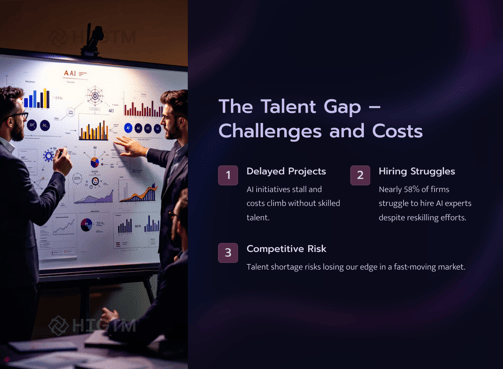

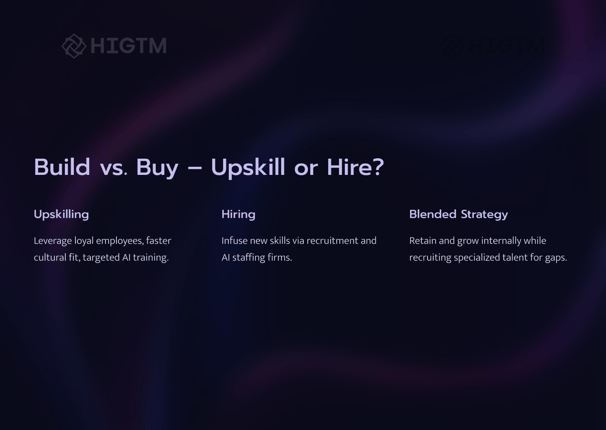

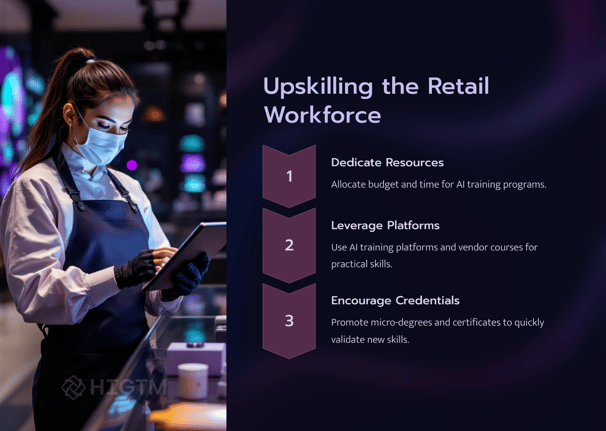

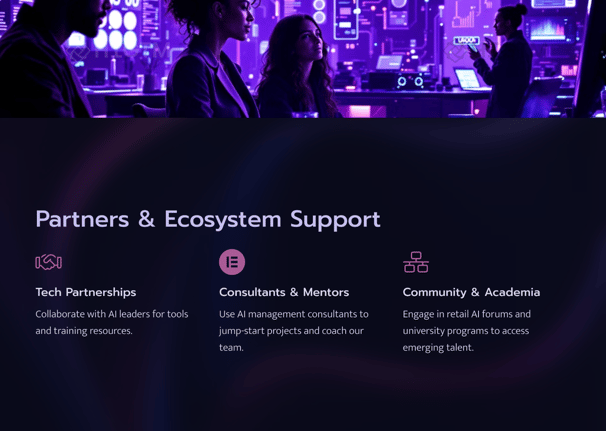

6. Recruit Strategically for AI Talent
Even as you cultivate your internal talent, you will likely need to hire for certain specialized skills or to bolster your team quickly. When approaching the job market for AI talent, especially as an SME, a strategic and targeted approach is vital:
Craft specific job descriptions: Avoid generic postings like “Data Scientist wanted”. Be clear about the context (“Retail SME seeking data scientist to build forecasting and recommendation models”) and the tech stack they’ll use (“experience with Python, scikit-learn, and cloud analytics on AWS preferred”). Specificity not only attracts the right candidates but also shows savvy talent that your company knows what it’s doing, which makes you more attractive as an employer.
Highlight exciting challenges: Top AI professionals are drawn to interesting problems. Emphasize the projects they’ll work on (“You’ll lead the implementation of a computer vision system to analyze store shelf stock in real-time” or “Build a recommendation engine from scratch for a niche apparel e-commerce platform”). Show how their work will have a tangible impact on the business (and is not just tweaking ad algorithms for a 0.1% lift – many will find retail’s variety of problems enticing).
Leverage AI staffing firms and networks: There are recruiting agencies specialized in tech and AI talent. Firms like Yoh, DataTeams, Insight Global, or Scion Tech maintain pipelines of data scientists and AI engineers. If an opening is critical, using these agencies or headhunters can speed up the search. They often have access to passive candidates that won’t see or respond to job board postings. Yes, it’s an added cost, but for key hires the investment pays off by securing talent faster.
Use LinkedIn and industry communities: Be active where AI professionals congregate. LinkedIn is obvious – share thought leadership posts about your AI in retail journey to build your brand image, then share job posts. Additionally, consider communities like Kaggle (for data scientists), tech meetups, or even AI forums on Reddit. Sometimes the best hires come from networking in professional groups rather than cold applications.
Assess both technical and business fit: When interviewing, evaluate candidates on their technical prowess (you might have a tech expert help with this if your team currently lacks the depth to quiz a data scientist) and their ability to understand retail business concepts. Someone might be a machine learning whiz but if they can’t relate to the concept of seasonal sales cycles or why customer experience matters, they might struggle to apply their skills effectively in your context. Present them hypothetical scenarios relevant to your business to see how they think.
Offer what matters: SMEs might worry about not being able to pay Silicon Valley salaries. While you should offer competitive compensation, remember that many people value other factors: growth opportunity, impact, flexibility, culture. You can craft an attractive package including a clear pathway for advancement (perhaps even heading up an AI division as it grows), the chance to own projects end-to-end, a stake in the company’s success (stock or profit-sharing, if available), and a positive work-life balance. Smaller companies can offer a sense of ownership and direct impact that big corporations sometimes can’t.
By being strategic, you’ll avoid the trap of endless hiring cycles. Each hire should be clearly justified by your needs assessment (from step 2) and plug into your AI roadmap. A smart hire not only fills a current gap but can elevate the whole team – for instance, a skilled data scientist might mentor your up-and-coming analysts (multiplying their effect, which leads to the next point). Recruiting for AI talent is competitive, but remember: you have advantages too. Many tech professionals would love to work on tangible problems at a growing retailer rather than be a tiny cog at a tech giant. Sell your vision, sell the impact, and you’ll attract believers who want to build something great with you.
7. Partner with AI Experts and Consultants for Immediate Impact
Building an internal team takes time – courses can take months, hiring can take even longer. In parallel, consider partnering with AI consultants or firms to kickstart your initiatives. This doesn’t replace growing your own talent, but rather jump-starts your AI projects and provides a learning opportunity for your team:
AI consulting firms: Engage with firms specializing in AI adoption for businesses. For example, HIGTM (High-Impact Go-To-Market) Management Consulting or other boutique AI consultants can come in, identify quick-win AI projects, and even implement pilot solutions. As they work, have them involve your staff as much as possible. It’s like hiring a tutor for your company – you get the job done and your people learn on the job.
Vendor solution architects: If you’re implementing a solution using a major provider (say a Salesforce AI module or Microsoft Dynamics 365 AI features), those companies often have solution architects or partners who can assist. These experts know the tool inside out. Bring them in to train your IT folks and ensure the initial configuration is solid.
Freelance experts: If a full consulting engagement is too much, consider hiring experienced freelancers or advisors. Perhaps a seasoned data scientist can be contracted for a few months to set up your data pipeline or to develop a prototype model, while mentoring an internal “understudy.” Websites like Upwork or Toptal can connect you with such talent, but personal networks often work best for finding reliable contractors.
Public-private partnerships: In some regions, economic development groups or government programs offer support for businesses looking to adopt AI, sometimes including mentorship or free consulting sessions. It’s worth researching if such programs exist in your area for SMEs.
When working with external experts, be clear that a goal (besides the immediate project) is knowledge transfer to your team. Structure contracts or agreements to include documentation, workshops, or pair-programming sessions so your employees pick up skills. For instance, if a consulting team is building a predictive sales model, make sure your analysts are shadowing them at key points, learning the techniques and tools. This way, when the engagement ends, you aren’t left with a “black box” you can’t maintain – your people will have grown.
Additionally, external experts can help you refine your longer-term talent plan. They have cross-industry experience and can advise on what roles and skills you should focus on. They might say, “In our experience with retailers, a data engineer to clean and structure data is often more important at first than a fancy AI scientist,” guiding your hiring priorities. In summary, don’t hesitate to seek outside help to accelerate your AI journey. The right partner can deliver quick results and elevate your internal capabilities simultaneously. Just remember to integrate these efforts with your overall talent strategy, so consultants are building bridges, not islands of expertise.
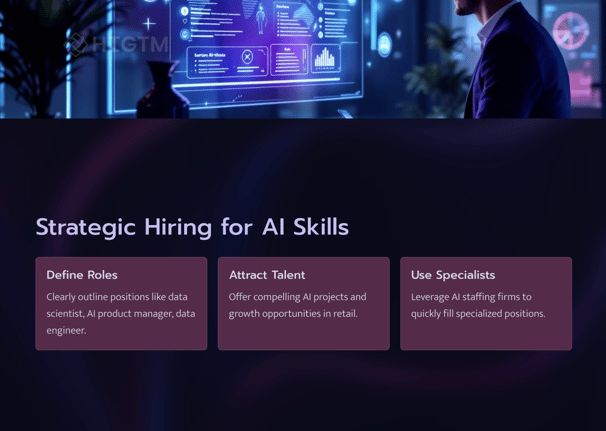

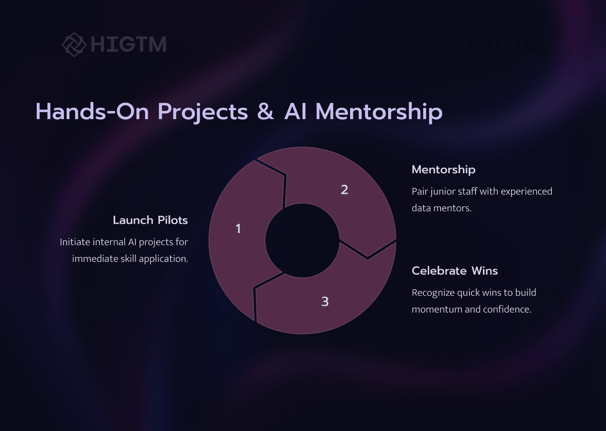

8. Foster a Hands-on Learning Culture (Projects & Mentorship)
Learning about AI in theory is important, but applying it in practice is where the rubber meets the road. To truly cement skills and drive innovation, create a culture of hands-on experimentation and mentorship in your organization. Here’s how:
Pilot projects: Identify small-scale, low-risk projects that can be your team’s playground for AI. These could be as simple as, “Can we use last year’s sales data to build a model that predicts next month’s sales?” or “Let’s trial an AI chatbot for common customer inquiries on our website.” Allocate a few interested employees (perhaps those who underwent training) to these pilots. The goal is not only to potentially get a useful tool but to let the team learn by doing. Keep the scope limited so that projects can finish in a matter of weeks, providing a sense of accomplishment.
Mentorship circles: Pair up less experienced team members with those who have more experience or training in AI. If you hired a data scientist, have them mentor your analytically-inclined marketing analyst. If your store manager took a course in machine learning, pair them with the junior IT person to collaborate on a data project. Mentorship should be structured – set aside an hour a week for knowledge sharing or problem-solving sessions. This pairing can also be external; you might engage an experienced mentor (perhaps an advisor or a friend of the company with AI expertise) to coach a group of your employees monthly.
Innovation lab mindset: Encourage a mindset that not all experiments will succeed – and that’s okay. If, say, a pilot to optimize staffing schedules with AI doesn’t yield a great model, the effort is still a success if the team learned something. Extract lessons: maybe the data quality was poor, or perhaps they realize they need more training in a specific algorithm. In a rapidly evolving field like AI, even failures are forward movement.
Cross-functional teams: Try mixing employees from different departments on an AI project. A customer service rep working with a data person on a chatbot means the solution will be both technically sound and user-friendly. It also helps diffuse AI know-how across domains. This breaks the silo mentality and embeds AI thinking company-wide.
Knowledge sharing: After a project or experiment, have the team present their findings to the rest of the company or department. Celebrate what was achieved (or attempted). This does two things: it gives recognition to the employees (boosting their confidence and status as newly minted AI practitioners) and it inspires others. Co-workers see “Hey, they built a forecasting tool that’s 10% more accurate than our old method – that’s cool! Maybe I should try something with my data too.”
By fostering an environment where playing with data and AI is encouraged, you essentially create an internal talent incubator. People will feel empowered to use their new skills without fear. A store clerk might come with an idea to use AI on scheduling, or a sales associate might use a visualization tool to analyze her own performance metrics – because the culture says “go for it.”
Mentorship ensures that as folks experiment, they have guidance to fall back on, reducing frustration. Over time, these practices make your organization a place where AI skills don’t just exist on paper, but are actively exercised daily. That’s when you truly start to reap the benefits of an AI-empowered workforce: not just knowledge, but action.
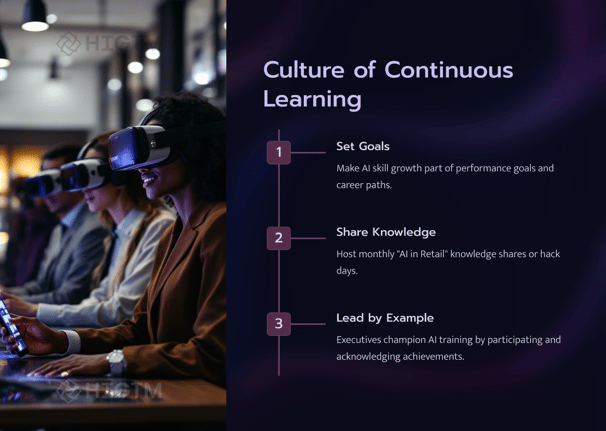

9. Cultivate an AI-Driven Culture and Career Pathways
To sustain momentum, AI must be woven into the fabric of your company’s culture and employee growth paths. Culture might sound intangible, but it has very real effects on whether your AI talent pipeline thrives or withers. Here’s how to cultivate a culture that nourishes AI talent:
Leadership advocacy: Company leaders should openly champion the AI initiative. When the CEO or department heads talk about how excited they are about a new AI tool the team developed, it signals to everyone that this is a long-term priority, not a fad. Leaders should also participate in learning – for example, a CEO might take a beginner’s course in AI for business or ask to sit in on internal tech demos. This visibility shows that everyone is on the journey together.
Communication and storytelling: Share success stories internally. Did a small AI tweak save the company $50k in logistics costs? Announce it. Did an employee earn a new certification? Celebrate them in the company newsletter or Slack channel. This positive reinforcement makes AI adoption part of the company narrative. It also encourages others to hop on the train (“Maybe I’ll be the next success story”).
Embed AI in values: If you have core values or principles, integrate the idea of innovation or continual learning. Make “Data-driven decision making” or “Innovate for impact” a stated company value. When employees see AI-related activities as fulfilling the company’s mission, they feel more purpose in pursuing them.
Career pathways: Perhaps the most motivating cultural element is showing employees that AI skills will advance their careers within your company. Work with HR to create or adapt career ladders that include AI competencies. For instance, your marketing coordinator role could have a path that branches: one path is traditional marketing manager, another is “Marketing Analytics Manager” which requires AI analytics skills. Show what roles can emerge – maybe a “Head of Data and AI” position in the future – and how one can get there. If people see a future for themselves, they’re more likely to invest in acquiring AI skills now.
Rewards and recognition: Consider formalizing how you reward AI-driven innovation. This could be through an awards program (e.g., quarterly “AI Innovator Award”), bonus incentives for projects that significantly improve metrics using AI, or even small perks like gift cards for those who complete training programs. Recognition from peers is powerful too – something as simple as shout-outs in team meetings for applying a new skill reinforces the behavior.
Inclusive approach: Ensure that AI opportunities are open to employees across the organization, not just IT. Sometimes frontline workers might feel “Oh, that’s technical stuff, not for me.” Break that barrier. If a warehouse supervisor wants to join a data project, welcome them. Diverse perspectives often lead to the most practical AI solutions. Plus, inclusivity in training helps avoid creating an elitist “AI team” and a non-AI team divide. Everyone should feel they are part of the transformation, which boosts overall morale and buy-in.
One of the insights from a Randstad survey highlighted a risk: many employees felt left behind in AI transformation, with unequal access to training (only o (AI skills gap widens: Employers embrace AI, but employees left behind - WorkLife) training while 75% of firms adopted AI). The lesson is clear – bring your people along. An AI-driven culture is one where employees at all levels are continuously learning, experimenting, and feeling valued for their contributions to innovation. Over time, as this culture takes root, you’ll notice AI becoming a natural consideration in projects (“How can we use data or AI to solve this?” becomes a common question). Your talent pipeline then becomes self-replenishing: new hires see a dynamic, modern workplace and are keen to join; current employees stay because they see growth and excitement. Essentially, by making AI part of your DNA, you ensure the investment in talent pays dividends long-term in loyalty, performance, and attracting even more talent.
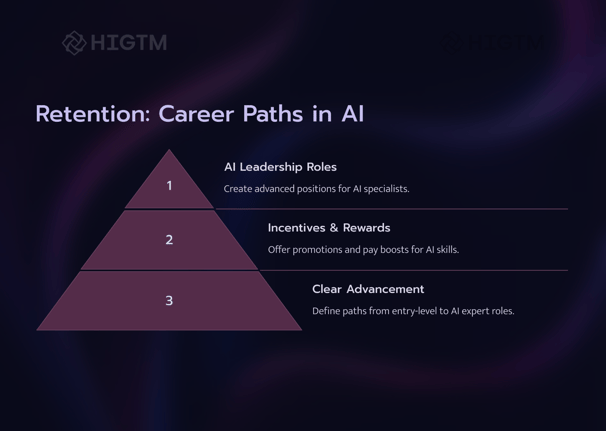

10. Measure Progress and Evolve Your Talent Strategy
As you implement these steps – training, hiring, partnering, culture-building – it’s crucial to measure your progress and remain agile. An AI talent pipeline is not a set-and-forget project; it’s an evolving strategy that should respond to both the results you achieve and the changes in technology and business environment. Here’s how to keep it on track:
Define KPIs for your talent initiative: Just as you have KPIs for sales or customer satisfaction, set KPIs for your AI talent development. This could include number of employees trained in AI skills, number of AI projects completed internally, reduction in time to fill AI-related positions, or improvements in business metrics attributable to AI projects (e.g., “AI-driven forecasting reduced out-of-stock incidents by 30%”). For example, you might aim to have 50% of your analytics team certified in a relevant AI skill within a year, or to complete 3 pilot projects per quarter.
Regular skills reassessment: Remember the skills gap analysis from step 2? Revisit it annually (or even semi-annually). Your business needs will evolve and so will technology. Perhaps a new tool emerged that requires a new skill, or maybe one area (like basic data analysis) is now well-covered by your team – great, but now you need to push into deeper machine learning skills. Continuously identifying new gaps will inform whether you need additional training, a new hire, or maybe even to bring in another consultant for a while.
Track retention and recruitment outcomes: Are your upskilled employees staying with the company longer? Ideally, yes – increased engagement through development often improves retention. Keep an eye on turnover rates, especially for those in AI-related roles. If people you’ve invested in are leaving, conduct exit interviews – is it salary, lack of advanced opportunities, or something else? That insight is gold for refining your approach (maybe you need to create more advanced roles to keep them challenged, for instance). Also track hiring metrics: how long does it take to hire for an AI role now versus before? Are you able to attract better candidates? A shortening time-to-hire or an uptick in candidate quality (perhaps measured by their experience or the offers they get elsewhere) indicates your pipeline is strengthening.
Monitor project ROI: For each AI project executed by your team, measure the outcome. If your newly trained team implemented an AI recommendation system on your website, how much did sales improve? This not only proves the value of the AI talent to any skeptics, but also helps justify further investment. According to McKinsey, AI-driven supply chain forecasting can (AI and retail: smart tips for selling online & in-store | Algolia) by 20-50% and lost sales by up to 65% – metrics like those should be captured if your talent applies similar solutions. When you can tie talent efforts to, say, a X% increase in efficiency or Y dollars saved, it creates a virtuous cycle: it’s easier to get budget for more talent development.
Stay updated on AI trends: The world of AI is fast. Today everyone’s talking about GPT-4; tomorrow it might be something like quantum AI or new regulatory requirements on AI use. Assign someone (or a small team) the role of “AI scout” – to periodically research and report on new trends that could affect your talent needs. For instance, if a new open-source AI tool drastically lowers the barrier to certain projects, maybe you don’t need that external hire you thought you did, because your current team can handle it with the new tool – or vice versa.
Feedback loops: Solicit feedback from your employees involved in the AI pipeline. Ask the trainees: how are the courses? Too hard, too easy, too theoretical? Ask the managers: are the new skills showing up in daily work? Do we utilize our new data scientist fully or is he stuck doing mundane tasks? This qualitative feedback is as important as the quantitative. It might reveal, for example, that employees crave more hands-on practice than the training provides – telling you to incorporate more project work in training. Or a manager might say the data scientist is underutilized, suggesting you need to initiate more projects to leverage that talent (or risk losing them to boredom).
Finally, be ready to pivot. Maybe you find that upskilling junior employees to become data analysts works better than hiring expensive seniors – so you double down on that. Or maybe an experiment with a certain bootcamp didn’t yield great results – time to try a different provider or method. The key is continuous improvement. By measuring and iterating, you ensure your AI talent pipeline doesn’t stagnate. Instead, it becomes a dynamic engine powering your business.
Each year, your team’s capability should noticeably increase, and your dependence on outside help should decrease correspondingly. In a couple of years, you might go from having essentially zero AI skills in-house to having a core team that others in the industry envy. That’s a real competitive moat. And it’s built not just on technology, but on the people who wield it – which, in the end, is much harder for competitors to replicate. By maintaining this adaptive, measured approach, your SME can confidently navigate the AI era, knowing your talent strategy is as advanced as the solutions you deploy.
Turn AI into ROI — Win Faster with HIGTM.
Consult with us to discuss how to manage and grow your business operations with AI.
© 2025 HIGTM. All rights reserved.
